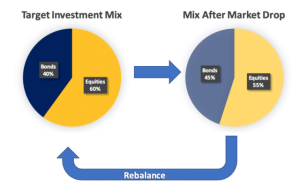Why rebalancing your portfolio in the midst of crisis is essential for long term success
In the midst of the COVID-19 pandemic, the term rebalancing now extends past investment portfolios as we all rebalance our lives around staying at home, creatively social distancing, and protecting our health. It is a rebalancing act that people did not anticipate; we’re all learning lessons that will linger on once this crisis is behind us.
The rebalancing that WealthStep does for 401k plans and “WealthStep Direct” individual clients, however, is investment portfolio rebalancing. This discipline of keeping a portfolio’s mix of investments in check is a critical part of a risk control and return enhancement process and allows for an unemotional way to help keep your plans on track.
Setting your target mix
When you choose your investment allocation, or asset allocation (that is, the mix of stocks, bonds and cash in your portfolio), that creates the target mix for rebalancing. Maintaining this target allocation, or mix, both on a broad basis (equities vs. fixed income), and with specific sub-groups (e.g. Foreign stocks vs. U.S. Small Cap or muni bonds vs. cash) is important for long-term risk and return purposes. Straying too far from these targets can be costly in terms of risk and potentially be a factor that keeps you from reaching your goals.
Let’s work through an example. If your target allocation is an investment portfolio with 75% equity and 25% fixed income, and the stock market (equities) drops so that the market value of your investments is now 70% equities and 30% bonds (see Figure 1 below), it is appropriate rebalance your portfolio. Your portfolio be adjusted to sell from your fixed income side and use the proceeds to buy equities (i.e. stocks) to balance your portfolio back to the 75%/25% target.
Technology Triggers & Human Help
Even though rebalancing into more stocks in a down market can feel uncomfortable like we have experienced over the past several weeks, it is no less critical to your long term success. In fact, it can magnify your long-term wealth. How do we know when the right time to rebalance is? For the portfolios we manage for participant-directed plans such as 401(k) plans and 403(b) plans, we rebalance on a regular schedule, and consider additional rebalancing if there are material market shifts. When it comes to WealthStep Direct, i.e. portfolios for assets outside of retirement plans, WealthStep leverages technology to identify two triggers for rebalancing.
1. 5% threshold: When the overall broad target mix shifts by 5% we receive an alert. For example, the Figure 1 portfolio changes from 60% equity to above 65% or below 55%.
2. Sub-asset class volatility-weighted tolerance: We evaluate based on thresholds for each type of equity or fixed income category (known as sub-asset classes) within the portfolio. The thresholds are based on the allocation to each sub-asset class and the projected volatility of each sub-asset class.
Crisis rebalancing may make a difference
While we rebalance to reduce risk and keep client portfolios aligned with their personal goals and tolerance for risk, some research indicates that rebalancing often improves portfolio performance. Analysis by BlackRock shows that an actively rebalanced 60/40 portfolio of indexes would have performed 1.72% higher versus not rebalancing during the 2008 Financial Crisis. Rebalancing when stocks are down systematically purchases stocks and lower prices, which magnifies the effect of the eventual recovery.
Of course, it is impossible to predict the perfect time to rebalance. A major market drop may be the bottom, or it could continue to a deeper bottom, and it can feel counter-intuitive and uncomfortable for clients to buy into a falling market. Nonetheless, the process of rebalancing has still been shown to be beneficial even when not perfectly timed.
Balancing risk and costs
A successful rebalancing strategy strikes a balance between maintaining the desired level of risk and incurring increased transaction costs. For taxable portfolios, tax loss harvesting can also add value. Conversely, where advantageous and possible, we target changes to take place in tax-deferred portfolios, if that is beneficial for the client, to minimize any negative tax impacts.
Smart rebalancing can be a complex process, but it is a critical part of long-term risk management and return enhancement, towards achieving client goals. While you have control over high-impact actions to help keep your goals on track, such as spending and saving consistent with the requirements of your long terms goals and plans, WealthStep support clients by taking the emotion out of volatility, keeping cool during crises, and rebalancing portfolios, as part of doing all that we can to serve our clients’ long-term goals.


